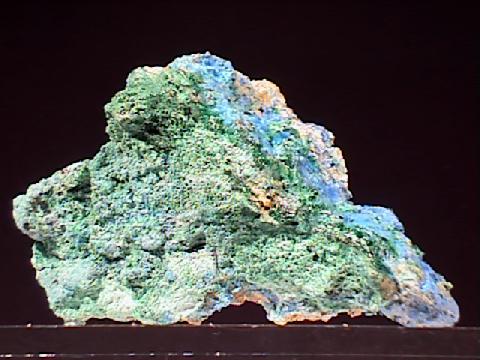
CYANOTRICHITE
Specimen cya-2
$ 110.00
Dims: 3.0 x 1.9 x 1.1" (7.6 x 4.8 x 2.8 cm)
Wt: 2.03 oz. (57.6 g)
Grandview Mine, Coconino County, Arizona, U.S.A.
This piece consists of a layer of fibrous Cyanotrichite that is sandwiched in between a pale brown, chalky host rock and a layer of either malachite or brochantite. The Cyanotrichite needles appear to be in generally good condition, though a few of the more exposed areas are crushed. The fine needles do not exceed 0.2" (5 mm) in length, and are thinner than human hairs, so their actual crystal form cannot be studied without high magnification. All have a pale blue color and likely a pearly luster, and are at least translucent on an individual basis. The brochantite or malachite mineral that coats the Cyanotrichite has a pale green color and is generally dull and massive, though several sprays of tiny, fibrous and radiating needles are visible. They are darker in color than the massive material and show a pearly luster.
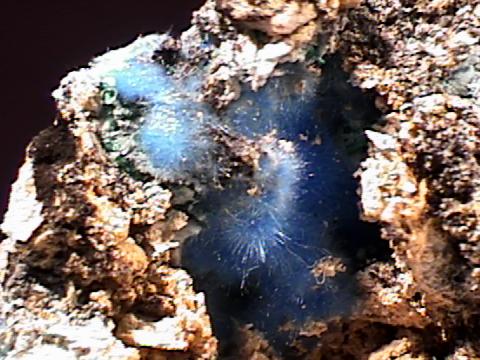
 Amethyst Galleries' Mineral Gallery MINERALS |
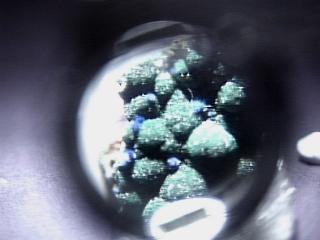
CYANOTRICHITE specimen cya-1
$ 20.00
$ 20.00
Dims: 1.3" x 0.9" x 0.5" (3.3 x 2.3 x 1.3 cm)
Wt: 10.0 g w/ foam base
Grandview Mine, Coconino County, Arizona, U.S.A.
This specimen consists of a base of four alternating layers of limonite and brochantite, on which are scattered several tiny, round radiating clusters of acicular Cyanotrichite crystals. Though one must use magnification to examine them in detail, the bright blue color and radiating habit of the clusters is visible to the naked eye. Their luster is somewhat silky due to their fibrous nature. Each cluster does not exceed 1 mm in diameter, but the brochantite crust upon which they rest has a botryoidal form and a deep green color, and thus gives a good contrast to the tiny clusters. Several more of these clusters are visible along the edges of the base, where the alternating layers of brochantite and limonite are visible. The specimen is affixed to a foam base that fits into a plastic specimen box.
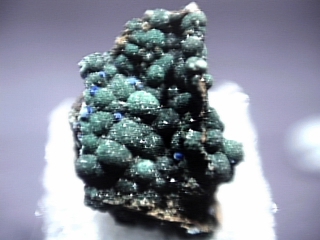

cya-1 ($ 20.00)
Grandview Mine, Coconino County, Arizona, U.S.A.

$ 110.00
Dims: 3.0 x 1.9 x 1.1" (7.6 x 4.8 x 2.8 cm)
Wt: 2.03 oz. (57.6 g)
Grandview Mine, Coconino County, Arizona, U.S.A.
This piece consists of a layer of fibrous Cyanotrichite that is sandwiched in between a pale brown, chalky host rock and a layer of either malachite or brochantite. The Cyanotrichite needles appear to be in generally good condition, though a few of the more exposed areas are crushed. The fine needles do not exceed 0.2" (5 mm) in length, and are thinner than human hairs, so their actual crystal form cannot be studied without high magnification. All have a pale blue color and likely a pearly luster, and are at least translucent on an individual basis. The brochantite or malachite mineral that coats the Cyanotrichite has a pale green color and is generally dull and massive, though several sprays of tiny, fibrous and radiating needles are visible. They are darker in color than the massive material and show a pearly luster.


Grandview Mine, Coconino County, Arizona, U.S.A.
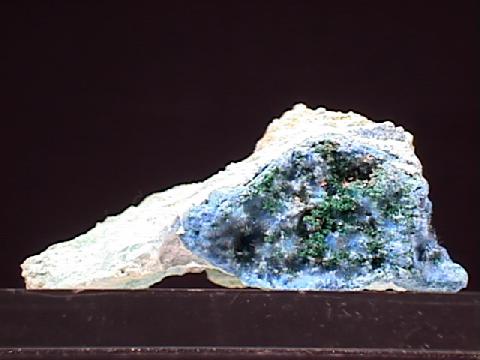
CYANOTRICHITE specimen cya-3
$ 49.00
$ 49.00
Dims: 2.0 x 1.0 x 1.0" (5.1 x 2.5 x 2.5 cm)
Wt: 12.4 g
Grandview Mine, Coconino County, Arizona, U.S.A.
A small crust of Cyanotrichite rests on the chalky host rock of this thumbnail specimen. The crust is made up of many tiny clusters, which in turn are made up of countless tiny Cyanotrichite needles. These needles are generally in very good condition, and are tiny- they do not exceed 0.1" (3 mm) in length, and each is much thinner than a human hair. Thus, their orthorhombic form cannot be studied except under very high magnification. They generally have a bright, pale blue color and a pearly luster, and individual crystals are likely translucent at the very least. They are accompanied by several sprays of brochantite needles that are considerably larger, but still very tiny. The pale, chalky host rock is partly colored blue and green due to inclusions of the aforementioned minerals.
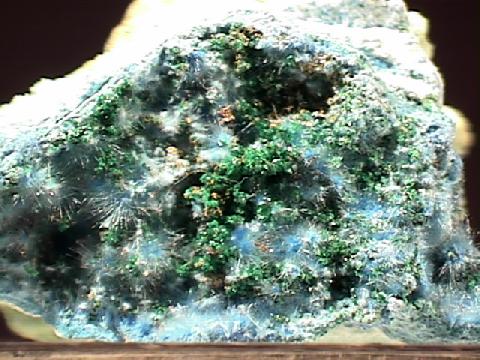

cya-3 ($ 49.00)
Grandview Mine, Coconino County, Arizona, U.S.A.
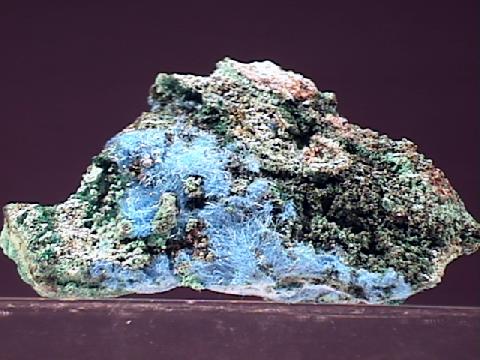
CYANOTRICHITE specimen cya-4
$ 30.00
$ 30.00
Dims: 1.8 x 0.9 x 0.7" (4.6 x 2.3 x 1.8 cm)
Wt: 14.8 g
Grandview Mine, Coconino County, Arizona, U.S.A.
This thumbnail specimen consists of a few small Cyanotrichite crusts that rest on what appears to be a brochantite base. The crust is made up of many tiny Cyanotrichite needles, most of which appear to be either crushed or matted down against the base. They do not exceed 0.1" (3 mm) in length, and are at least as thin as a human hair. They are too thin for me to effectively study their form. All have the classic pale blue coloration and pearly luster of their species, and are likely transparent as individuals. The base on which they rest is mostly massive in form, but a few areas contain many thin, green needles.

cya-4 ($ 30.00)
Grandview Mine, Coconino County, Arizona, U.S.A.
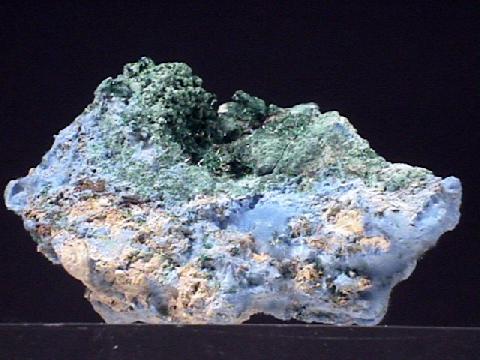
CYANOTRICHITE specimen cya-5
$ 32.00
$ 32.00
Dims: 1.7 x 1.0 x 1.0" (4.3 x 2.5 x 2.5 cm)
Wt: 10.1 g
Grandview Mine, Coconino County, Arizona, U.S.A.
This thumbnail specimen consists of of both massive and crystalline Cyanotrichite that is interspersed with brochantite and a pale brown host rock. The Cyanotrichite that is in crystalline form occurs as a bed of superfine needles that do not exceed 0.1" (3 mm) in length and are much thinner than a human hair. All have the classic pale blue color and dull, almost silky luster of their species. The accompanying brochantite also occurs in both massive and crystalline form- the brochantite needles are of a similar length, not exceeding 0.1" (3 mm), but are considerably thicker. They have the standard dark green color of their species and possess a rather bright pearly luster. The host rock is likely made of a shale or a finely-grained siltstone or sandstone, as it is powdery and soft.

cya-5 ($ 32.00)
Grandview Mine, Coconino County, Arizona, U.S.A.
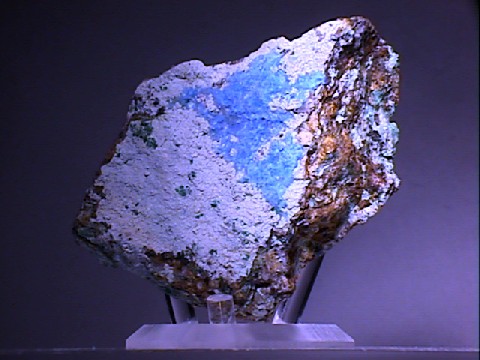
CYANOTRICHITE specimen cya-7
$ 113.00
$ 113.00
Dims: 3.7 x 2.7 x 1.3" (9.4 x 6.8 x 3.2 cm)
Wt: 4.6 oz. (131 g)
Maid-of-Sunshine Mine, Arizona, U.S.A.
A matte of countless tiny, fibrous Cyanotrichite needles rests on the rusty-brown base of this cabinet specimen. These needles do not exceed 2 mm in length and are too small and fine to examine effectively even with a loupe. Almost all of them have been matted down or crushed, and a powerful microscope is needed to study their orthorhombic form. Their color is sky-blue and their luster appears to be pearly, though the entire matte has a dull, silky luster. They are likely at least translucent. They rest on a bed of what I have been told is allophane, an apparently amorphous, hydrous aluminum silicate- it does appear, however, to show some nodular, almost botryoidal form, and has a pale, dull, blue-gray color and dull luster. A small amount of brochantite also appears to be present.
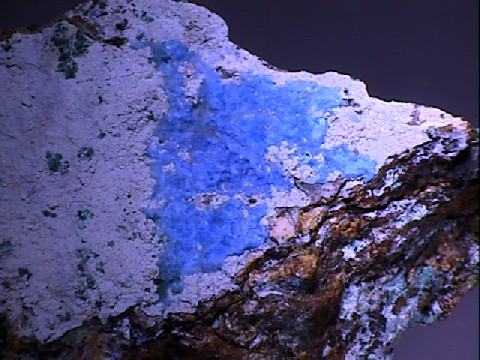

cya-7 ($113.00)
Maid-of-Sunshine Mine, Arizona, U.S.A.
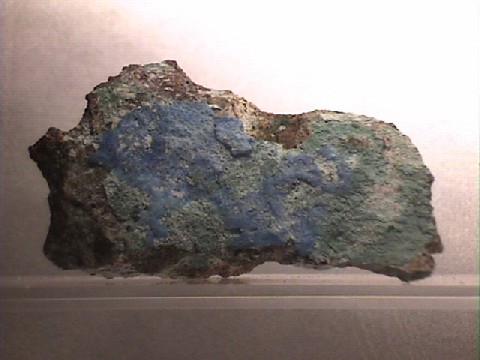
CYANOTRICHITE specimen cya-6
$ 150.00
$ 150.00
Dims: 4.2 x 2.4 x 2.4" (10.7 x 6.2 x 6.1 cm)
Wt: 7.8 oz. (221 g)
Maid-of-Sunshine Mine, Arizona, U.S.A.
A mat of intergrown Cyanotrichite needles partly coats the brown base rock of this cabinet specimen. This mat is in moderately good condition, showing visible crushing damage in a few places, and is made up of perhaps thousands of needles that do not exceed 1 or 2 mm in length- they are certainly too small and fine to study with a loupe. All have a pale blue color, and the matte has a silky luster in places. A few other secondary copper minerals also rest on the base rock.
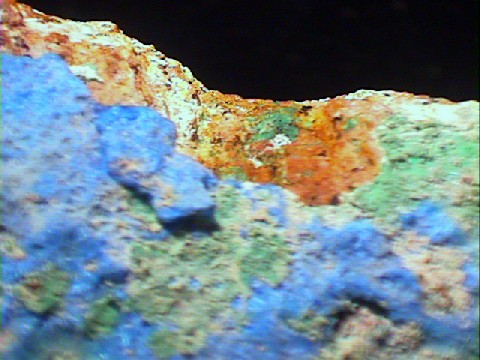

cya-6 ($150.00)
Maid-of-Sunshine Mine, Arizona, U.S.A.
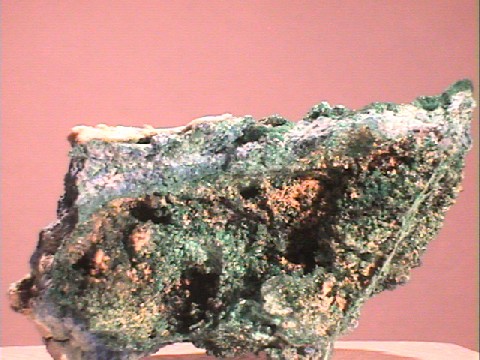
CYANOTRICHITE specimen cya-8
$ 80.00
$ 80.00
Dims: 2.5 x 1.8 x 1.7" (6.3 x 4.5 x 4.2 cm)
Wt: 2.5 oz. (72 g)
Grandview Mine, Coconino County, Arizona, U.S.A.
Both massive crusts and fibrous mattes of Cyanotrichite are present on this small cabinet specimen. The mattes are the most obvious, covering a portion of the surface of the specimen, and are in moderately good condition, showing considerable crushing damage. The crystals therein measure up to 0.1" (3 mm) in length and perhaps more, but are far too fine for effective study without a powerful microscope. The massive crust shows no crystal form, of course. Both have the sky blue color that is standard for the specie and the matte and crust have respective silky and dull lusters. The Cyanotrichite is accompanied by crusts and druses of brochantite, and perhaps some malachite.
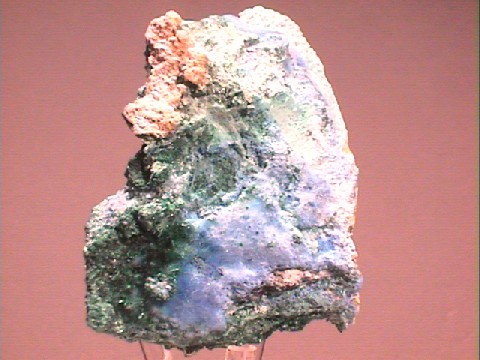

cya-8 ($ 80.00)
Grandview Mine, Coconino County, Arizona, U.S.A.
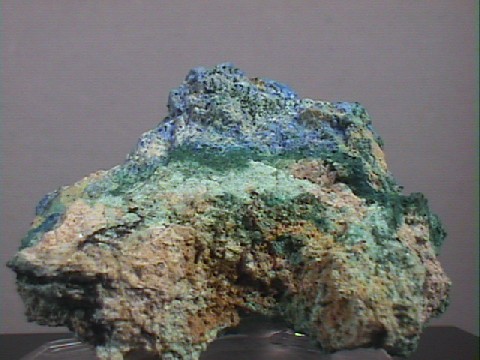
CYANOTRICHITE specimen cya-9
$ 30.00
$ 30.00
Dims: 2.3 x 1.8 x 1.0" (5.7 x 1.8 x 1.0 cm)
Wt: 1.4 oz. (40 g)
Grandview Mine, Coconino County, Arizona, U.S.A.
This hand specimen consists of a pale host rock through which extends both fibrous and massive Cyanotrichite. The fibrous material shows considerable crushing damage, and crystals are too small (length: 1-2 mm) and fine to effectively study with a loupe. The massive material shows no crystal form and has a dull luster, as opposed to the silky luster of the fibrous material. Both have the pale blue color that is common for Cyanotrichite. A vein of crystalline and massive brochantite and/or possibly malachite also extends through the host rock.

cya-9 ($ 30.00)
Grandview Mine, Coconino County, Arizona, U.S.A.